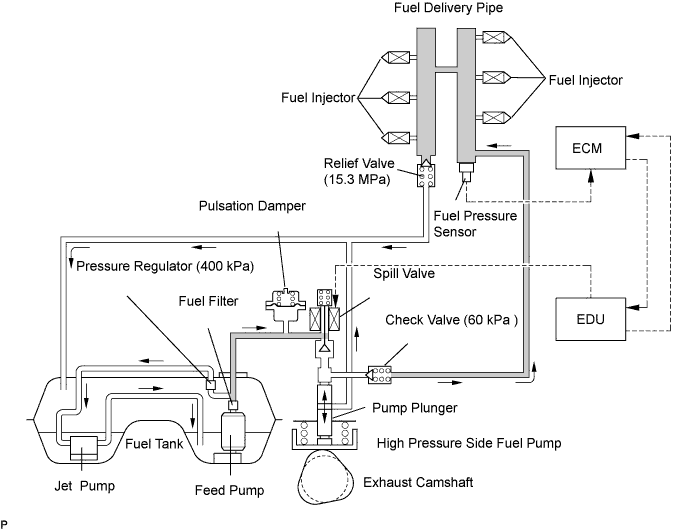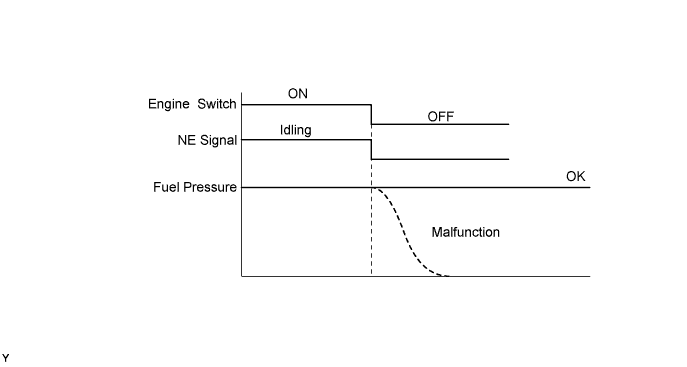CHECK FUEL LEAKAGE (HIGH PRESSURE SIDE)
CHECK OTHER DTCS OUTPUT (IN ADDITION TO DTC P0087)
CONFIRM IF VEHICLE HAS RUN OUT OF FUEL IN PAST
CHECK MISFIRE COUNT (CYL #10, #20, #30, #40, #50 AND #60)
CHECK FUEL PRESSURE (LOW PRESSURE SIDE)
CHECK FUEL LEAKAGE (HIGH PRESSURE FUEL LINE)
REPLACE FUEL PUMP (HIGH PRESSURE SIDE)
CHECK IF DTC OUTPUT REOCCURS (SEE IF DTC P0087 IS OUTPUT AGAIN)
DTC P0087 Fuel Rail / System Pressure - Too Low
Description
The high-pressure fuel system consists of the spill valve, pump plunger, check valve, relief valve and fuel pressure sensor. The spill valve opens and closes the low-pressure fuel line (from the fuel tank), the pump plunger operated by the camshaft pressurizes fuel, the check valve mechanically opens and closes the high pressure fuel line (to the fuel delivery pipe), the relief valve prevents fuel pressure from becoming extremely high, and the fuel pressure sensor located on the fuel delivery pipe monitors fuel pressure. The high-pressure side fuel pump is installed to the cylinder head cover (bank 1) and is driven by the cam located at the rear end of the exhaust camshaft. Let the plunger moves up and down by the camshaft rotations, it produces vacuum to suck fuel and pressurizes the fuel. This fuel then pushes the check valve open and flows into the fuel delivery pipe. The ECM opens and closes the spill valve to regulate the fuel pressure to the target fuel pressure 4 to 13 MPa (40.8 to 132.6 kgf/cm2, 580 to 1,885 psi). In order to obtain and maintain the target pressure, the ECM monitors the fuel pressure using the fuel pressure sensor and performs the feedback control. If the internal fuel pressure of the fuel delivery pipe exceeds the standard pressure 15 MPa (153 kgf/cm2, 2,175 psi), the fuel relief valve installed on gateway of the fuel delivery pipe discharges the fuel pressure and then returns the fuel back to the fuel tank.

| DTC No. | DTC Detection Condition | Trouble Area |
| P0087 | Despite ECM commanded that the high pressure fuel pump opens the spill valve, fuel pressure decreases 5 MPa (51.0 kgf/cm2, 725 psi) for more than 10 seconds (1 trip detection logic) |
|
Wiring diagram
Refer to DTC P0190 .
Inspection procedure
HINT:
- If different DTCs related to different systems that have terminal E2 as the ground terminal are output simultaneously, terminal E2 may have an open circuit.
- Read freeze frame data using the intelligent tester. Freeze frame data records the engine conditions when malfunctions are detected. When troubleshooting, freeze frame data can help determine if the vehicle was moving or stationary, if the engine was warmed up or not, if the air-fuel ratio was lean or rich, and other data from the time the malfunction occurred .
| 1.CHECK FUEL LEAKAGE (HIGH PRESSURE SIDE) |
-
Check around and beneath the car for gasoline leaks, fumes, etc.
OK:
No gasoline leaks present.
|
|
||||
| OK | |
| 2.CHECK OTHER DTCS OUTPUT (IN ADDITION TO DTC P0087) |
-
Connect the intelligent tester to the DLC3.
-
Turn the engine switch on (IG) and turn the tester ON.
-
Clear DTCs.
-
Start the engine.
-
Enter the following menus: Power train / Engine / DTC.
-
Read the DTCs using the intelligent tester.
Result:
Display (DTC output) Proceed to P0087 A P0087 and other DTCs B
HINT:
If any other codes besides P0087 are output, perform troubleshooting for those DTCs first.
|
|
||||
| A | |
| 3.CONFIRM IF VEHICLE HAS RUN OUT OF FUEL IN PAST |
-
Has the vehicle run out of fuel in the past?
|
|
||||
| NO | |
| 4.CHECK MISFIRE COUNT (CYL #10, #20, #30, #40, #50 AND #60) |
-
Connect the intelligent tester to the DLC3.
-
Turn the engine switch on (IG) and turn the tester ON.
-
Enter the following menus: Power train / Engine / Data List / Cylinder #1 (to #6) Misfire Rate.
-
Allow the engine to idle.
-
Read each value of CYL #1 to #6 displayed on the tester.
-
Check if there is a particular cylinder that the misfire count is concentrated on.
Result:
Misfire Count Proceed to No misfire counts, or misfire counts occur randomly in all cylinders A Misfire counts occur in particular cylinder B
|
|
||||
| A | |
| 5.CHECK FUEL PRESSURE SENSOR |
-
Connect the intelligent tester to the DLC3.
-
Start the engine.
-
Turn the tester ON.
-
Enter the following menus: Power train / Engine / Data List / Fuel Press.
-
Check that the fuel pressure fluctuates when the engine condition changes from idling to racing.
Result:
Inspection Result Proceed to Fuel pressure does not fluctuate A Fuel pressure fluctuates B Fuel pressure does not rise C
|
|
||||
|
|
||||
| C | |
| 6.CHECK OPERATION OF FUEL PUMP |
-
Check the fuel pump operation.
|
|
||||
| OK | |
| 7.CHECK FUEL PRESSURE (LOW PRESSURE SIDE) |
-
Check the fuel pressure (low pressure side) .
|
|
||||
| OK | |
| 8.CHECK FUEL LEAKAGE (HIGH PRESSURE FUEL LINE) |
-
Connect the intelligent tester to the DLC3.
-
Turn the engine switch on (IG) and turn the intelligent tester ON.
-
Enter the following menus: Power train / Engine / Data List / Fuel Press.
-
Start the engine.
-
Check that the fuel pressure fluctuations when the engine switch is turned off.
HINT:
Turn the engine switch off and on (IG) before checking the fuel pressure.

Result:
Inspection Result Proceed to Fuel pressure is almost constant, or fluctuations are gradual A Fuel pressure drops suddenly B
|
|
||||
| B | |
| 9.CHECK RELIEF VALVE |
-
Connect the intelligent tester to the DLC3.
-
Turn the engine switch on (IG) and turn the intelligent tester ON.
-
Enter the following menus: Power train / Engine / Data List / Fuel Press.
-
Start the engine.
-
Check that the fuel pressure fluctuations when the fuel hose is pressed with your fingers.
Result:
Inspection Result Proceed to Pressing the hose raises the fuel pressure slightly A Fuel pressure does not fluctuate B
|
|
||||
| B | |
| 10.REPLACE FUEL PUMP (HIGH PRESSURE SIDE) |
| NEXT | |
| 11.CHECK IF DTC OUTPUT REOCCURS (SEE IF DTC P0087 IS OUTPUT AGAIN) |
-
Connect the intelligent tester to the DLC3.
-
Turn the engine switch on (IG) and turn the tester ON.
-
Clear DTCs.
-
Start the engine.
-
Enter the following menus: Power train / Engine / DTC.
-
Read the DTCs using the intelligent tester.
Result:
Display (DTC output) Proceed to P0087 A No output B
|
|
||||
| A | ||
|
||